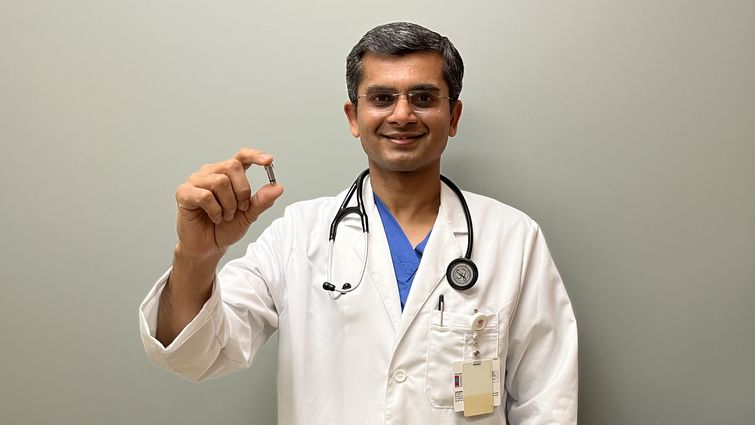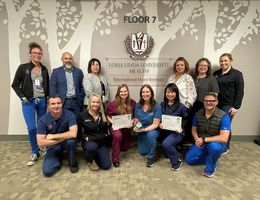

Dr. Harit Desai, associate director for the cardiac catheterization lab and structural heart intervention program at LLUMC – Murrieta, holds the world's smallest pacemaker — a device that expands and improves cardiac care services for patients in the region.
The heart team at Loma Linda University Medical Center – Murrieta recently performed its first procedure using the world’s smallest FDA-approved pacemaker. Compared to a traditional pacemaker, the tiny, leadless pacemaker offers patients less risk for medical complications, little to no scarring, fewer post-implant activity restrictions, and faster recovery.
The device also allows for a new subset of patients to benefit from receiving a pacemaker, says Harit Desai, MD, the associate director for the cardiac catheterization lab and structural heart intervention program at LLUMC – Murrieta.
“We are proud of this milestone and newfound opportunity to provide expanded and improved cardiac care for patients in the community,” Desai said.
The device, called a Micra Pacemaker, is a pacing system used to treat a slow heart rate, a condition called bradycardia. About the size of a large vitamin capsule, the pacemaker is 93% smaller than conventional pacemakers. Additionally, Desai says the device is self-contained, meaning that, unlike traditional pacemakers placed in a patient's chest with wires called leads connecting to the heart, leadless pacemakers are implanted directly into the heart’s right ventricle.
Desai says the leadless pacemaker’s size and placement eliminate many of the risks inherent to having a conventional pacemaker, such as potential medical complications arising from a chest incision, lung injury, or complications from the leads running into the heart.
Desai says bradycardia patients who are not candidates for traditional pacemakers can still benefit from leadless pacemakers thanks to these advantages that “open new doors” to them. For example, Desai says patients with blocked or scarred veins from treatments like kidney dialysis or chemotherapy port for cancer therapy can now benefit from the leadless pacemaker.
This leadless pacemaker therapy is just another advancement for LLUMC–Murrieta, enabling us to offer all types of advanced heart-related procedures from structural to vascular and cardiac.Dr. Harit Desai
To implant the leadless pacemaker in a minimally invasive fashion, a cardiologist punctures a vein in the leg. Through this small puncture, the cardiologist uses x-ray imaging and a catheter to guide a small pacemaker to the heart’s right ventricle, where the device deploys.
The procedure takes less than an hour and usually allows patients to go home the same day or the next day, Desai says. In contrast, a traditional pacemaker requires several weeks of recovery with restrictions for arm movements and showering. Once implanted, the pacemaker runs on a long battery life of 8 to 13 years. He adds that patients with the pacemaker will not experience any restrictions related to MRI scans. Finally, Desai says the small device leaves no scarring or bumps nor involves any chest-incision-related risks, such as an infection.
Desai advises being aware of the symptoms of bradycardia, which include: fatigue or weakness, dizziness or lightheadedness, confusion, fainting or near-fainting, shortness of breath, or chest pain.
"If you feel any of these symptoms, contact your care provider," Desai says. "They will investigate, determine the cause, and discuss the next steps with you.”
For the time being, Desai says this leadless pacemaker is implanted in the bottom chamber of the heart and does not help conditions related to the heart's top chambers. However, he says future developments with the device may expand its capabilities.
“This leadless pacemaker therapy is just another advancement for LLUMC–Murrieta, enabling us to offer all types of advanced heart-related procedures from structural to vascular and cardiac,” Desai says. “We are excited to be able to offer this new option to our community and to continue bringing advanced heart care and technology to our area.”
To learn more about heart care services offered at Loma Linda University Medical Center – Murrieta, visit the Heart Care webpage or call 951-290-4000.


